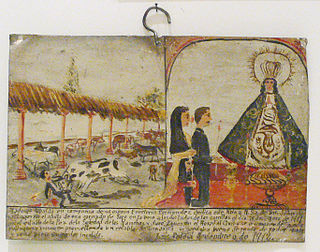
An ex-voto is a votive offering to a saint or a divinity, given in fulfillment of a vow or in gratitude or devotion. The term is usually restricted to Christian examples.

The Presentation at the Temple is a painting of the Presentation of Jesus at the Temple by the Italian master Giovanni Bellini, dating to c. 1460. It is housed in the Fondazione Querini Stampalia, in Venice, Italy.
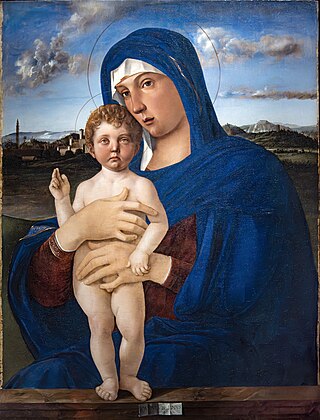
The Contarini Madonna is an oil painting by the Italian Renaissance master Giovanni Bellini, dating from c. 1475–1480 now in the Gallerie dell'Accademia in Venice.
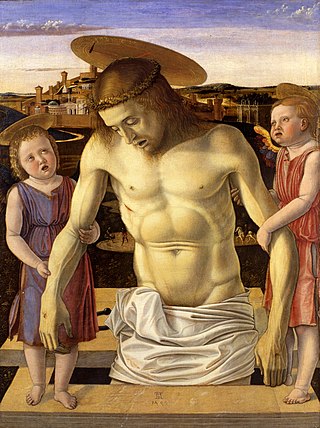
Dead Christ Supported by Two Angels is a tempera painting on panel by the Italian Renaissance painter Giovanni Bellini, created around 1460. It is now in the Museo Correr in Venice.

The Madonna with Child, or Alzano Madonna, is an oil-on-panel painting by Italian Renaissance artist Giovanni Bellini, executed around 1485.
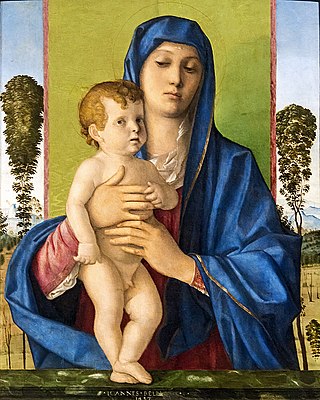
The Madonna of the Small Trees is an oil-on-panel painting by Italian Renaissance artist Giovanni Bellini, executed in 1487. It is housed in the Gallerie dell'Accademia in Venice.

St. Mark Preaching in Alexandria is an oil painting by the Italian Renaissance artists Gentile and Giovanni Bellini, dated to 1504–1507, and held in the Pinacoteca di Brera, in Milan.
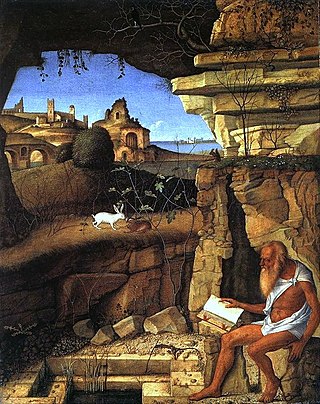
St. Jerome in the Desert is a 1505 oil-on-canvas painting by the Italian Renaissance master Giovanni Bellini, now in the National Gallery of Art in Washington. Little remains of the signature on the first rock in the left foreground, but it has been confirmed as genuine during restoration and can be reconstructed as "[Johannes Bellinu]s. 1505". This is problematic, since the work's general style is linked to fashions no later than 1490, whereas Bellini's style of figures and landscapes had already begun to be influenced by Giorgione by 1500, with the backgrounds more fused and unified in terms of atmosphere. The composition makes it more analogous to his earlier works, such as the c. 1480 St. Jerome in the Desert. The Washington work may have been a collaboration, a work completed by a pupil in Bellini's studio or left incomplete and only finished by Bellini himself much later.
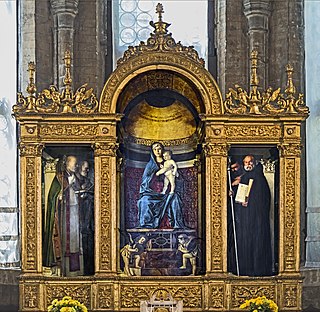
The Frari Triptych or Pesaro Triptych is a 1488 oil-on-panel triptych painting by the Italian Renaissance master Giovanni Bellini. It is signed and dated 1488 on the centre of the Virgin Mary's throne, though it may have taken several years to produce, meaning he started it in 1485. On the reverse is a label dating its completion more precisely, to 15 February 1488. It is in the basilica di Santa Maria Gloriosa dei Frari in Venice.
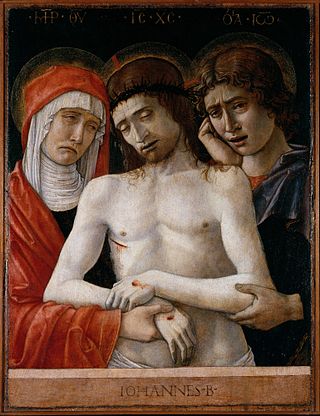
The Pietà or Christ's Body Supported by the Virgin Mary and St John the Evangelist is a tempera-on-panel painting by the Italian Renaissance artist Giovanni Bellini, now in the Accademia Carrara in Bergamo. Dated to around 1455, it is one of his earliest independent works and the prototype for his series of pietàs. It draws on Byzantine icons of the 'imago pietatis', of which there were many examples throughout Venice, and of 'Ritratti di Passione' or 'portraits of the Passion', in which the dead Christ invites the viewer to contemplate his wounds. The crossed arms are drawn from a famous Roman mosaic-icon from Santa Croce in Gerusalemme basilica which was held to be miraculous and had according to legend been commissioned by pope Gregory the Great based on a vision during a mass.

Pietà or Dead Christ Supported by Angels is a tempera-on-panel painting by the Italian Renaissance artist Giovanni Bellini, now in the city museum of Rimini. It is dated to around 1470, making it one of his early mature works, around the same time as another of his Pietà (Brera).

Pietà or The Dead Christ Supported by the Virgin Mary and St John the Evangelist is a c. 1465–1470 tempera-on-panel painting by the Italian Renaissance artist Giovanni Bellini, now in the Pinacoteca di Brera in Milan.

The Saint Vincent Ferrer Altarpiece is a tempera-on-panel painting by Giovanni Bellini, dating to 1464–1470 and still in on the altar dedicated to Saint Vincent Ferrer at Santi Giovanni e Paolo, Venice, for which it was originally commissioned. Ferrer was a Spanish Dominican who had only been canonised in 1455 and his order was continuing to promote his cult.

Pietà is a tempera-on-panel painting executed c.1455–1460 by the Italian Renaissance artist Giovanni Bellini, now in the Museo Poldi Pezzoli in Milan. One of his earliest works, it is the prototype for his long series of other Pietas such as Pietà (Bergamo).
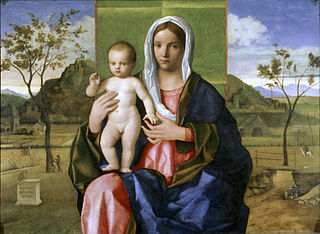
The 'Madonna and Child or Madonna with the Christ Child Blessing is a 1510 oil-on-panel painting by the Italian Renaissance master Giovanni Bellini, painted when he was already in his eighties but still responding to new developments in painting. It is similar to the 1505 Madonna del Prato and the 1509 Madonna and Child. It is now in the Pinacoteca di Brera in Milan.

Madonna and Child is a c. 1460–1465 tempera painting on panel by the Italian Renaissance artist Giovanni Bellini, signed on the trompe-l'œil parapet. It dates from his early phase, when he was still strongly influenced by his father Jacopo and by Andrea Mantegna. The Christ Child holds a fruit, symbolising Original Sin and foreshadowing his Passion. Some art historians feel the haloes and drapery are too archaic for the work to be by Bellini, but the signature's authenticity was confirmed by a 1999 restoration.

The Greek Madonna is a 1460–1470 tempera-on-panel painting by the Italian Renaissance artist Giovanni Bellini. It is named after the Greek monograms at top left and top right and after the major influence of Byzantine icons on the painting. The Christ Child holds a golden apple, perhaps referring to the Judgement of Paris and to Mary as the "new Venus".

The Madonna and Child with Saint Catherine and Saint Mary Magdalene is an oil on panel painting by Giovanni Bellini, formerly in the Renier Collection in Venice and now in that city's Gallerie dell'Accademia. It dates to 1490, just after the Barbarigo Altarpiece and belongs to the popular sacra conversazione genre. The painting is also referred to as Sacred Conversation.

The Madonna and Child with St. John the Baptist and a Female Saint or the Giovanelli Sacred Conversation is an oil painting on panel by the Italian Renaissance master Giovanni Bellini, dated to before 1504. It is kept in the Gallerie dell'Accademia of Venice.

The San Lorenzo Triptych is a tempera-on-panel altarpiece by the Italian Renaissance artist Giovanni Bellini and others. Its central panel of Saint Lawrence measures 127 by 48 cm, its lunette of the Madonna and Child 59 by 170 cm and its side panels of John the Baptist and Antony of Padua 103 by 45 cm each. It is now in the Gallerie dell'Accademia in Venice.




















